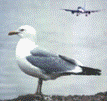Bird Strike Committee Proceedings

Bird Strike Committee-USA/Canada Joint Annual Meeting: 8th (2006)
Date of this Version
August 2006
Document Type
Article
Abstract
Canada goose (Branta canadensis) populations in North America are subdivided into “migrant-goose” and “large-goose” populations. The “large-goose” populations consist primarily of flocks that are non-migratory (hereafter referred to as resident geese). Estimated migrant and resident geese numbers in the four flyways (Atlantic, Mississippi, Central, and Pacific) are based on mid-winter or breeding period counts. The overall Canada goose population increased five fold from 1970 (1.08 million) to 2005 (5.01 million). Most of this overall increase was due to a 15-fold increase in the population of resident geese (from 0.2 to 3.4 million), especially during the 1990s when the population increased at a mean annual rate of 13.8%. Since 2000, the resident Canada goose population has stabilized at about 3.4-3.6 million. The migrant population has remained relatively stable since 1990 with the population in 2005 estimated at 1.7 million. Resident geese comprised 67% of the total Canada goose population in 2005 compared to 38% in 1990 and only 18% in 1970. Resident Canada geese are of particular concern to aviation because of their large size, flocking behavior, use of airports for grazing, and year-round presence in urban environments. From 1990 to 2005, 1,279 Canada goose and “goose” (unidentified to species but likely Canada geese) strikes with civil aircraft were reported in the USA of which 675 (53%) caused damage. Damage to one or more engines was reported in 163 cases. The number of reported Canada goose and “goose” strikes per year increased, in concert with the increase in the resident population, from 39 in 1990 to 115 in 1998. However, reported strikes declined since 1998 to 70 in 2005 in spite of the continued high overall resident population. This decline is likely due to aggressive Canada goose management programs implemented at many airports and other urban areas. These programs must be continued and expanded to reduce this significant hazard to aviation.

